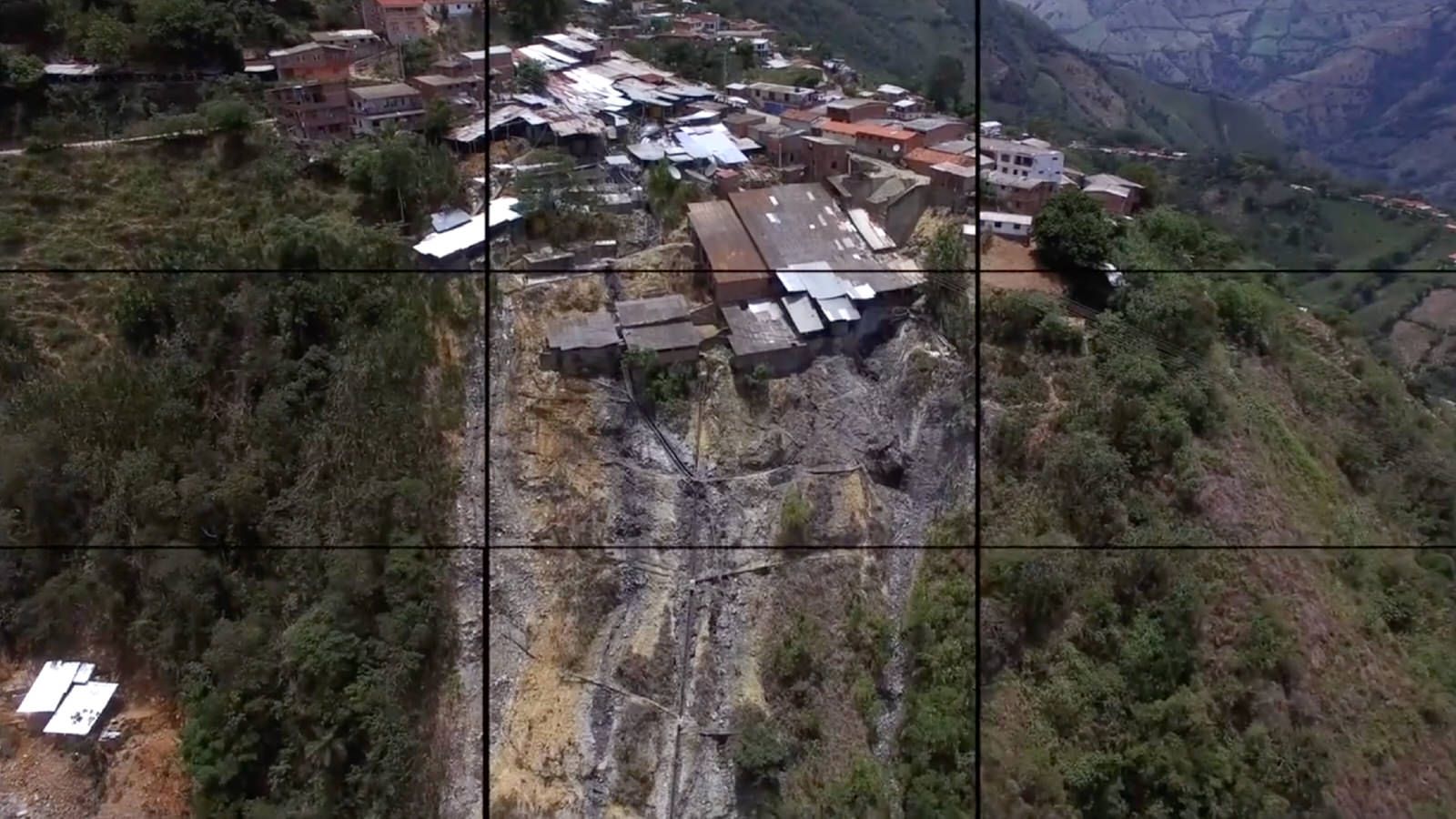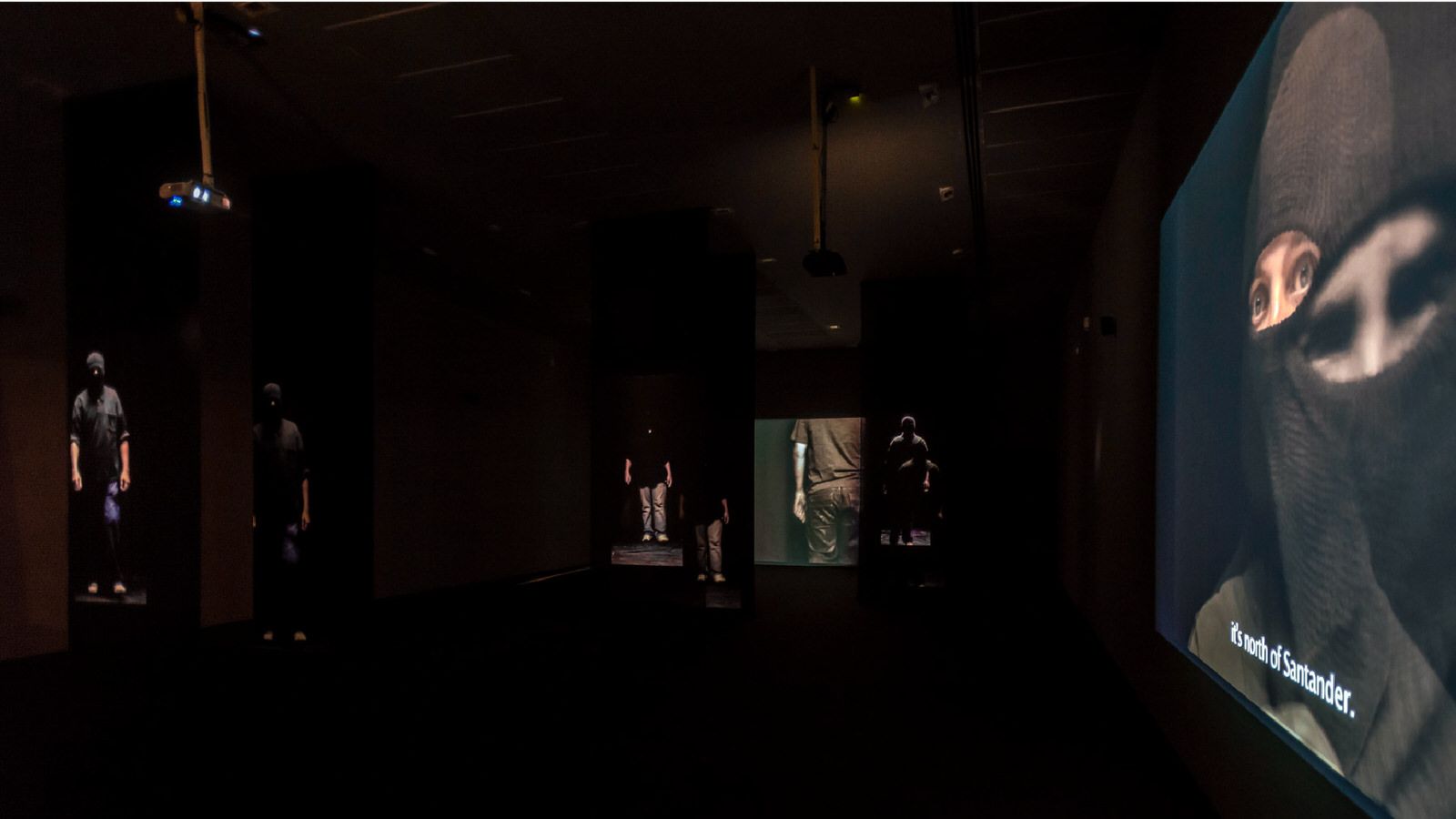
River by Assault
River by Assault (2018)
“Artists fly higher and farther than our politicians and businessmen usually do. And this very week has come to prove it the opening of the XII edition of the Shanghai International Art Biennale, a mega art exhibition that brings together works by a hundred long artists from around the world, among which stands out Clemencia Echeverri’s Rio by Assault. A striking video installation of six floor-to-ceiling screens that responds to the lasting concern of this great artist for the fate of Colombia’s rivers. Rivers that she has incorporated into her work to evoke the horrors of the nameless war that we have suffered for so many years and that still strikes deadly blows. Rivers as dumps of corpses thrown into its waters by murderers in search of impunity. Rivers that have drowned in their roar the screams of the survivors. Rivers as powerful as storms or earthquakes, rivers like the Cauca River evoked with force in this moving sequence of images. In Ituango, as is well known, it was decided ten years ago to build a hydroelectric power plant, including the dam that will create an artificial lake seven kilometers long and millions of hectoliters of water under which villages, crops and forests will be buried.
The neighbors were opposed, as were the ecologists, convinced that the problems caused by these mega-projects far outweigh the benefits expected from them. There are other alternatives,” they said. However, megalomania has a high price, and a few months ago some of the works gave way to the pressure of the waters and collapsed. The announcements of catastrophe were fulfilled. The project is now on hold and from the impasse Clemencia Echeverri has composed a work that is the syncopated chronicle of the Cauca River, of its meek emergence from the bowels of the Earth, of the increasingly impetuous growth of its flow, of its imprisonment, of the fury with which it broke the dam, of the death and destruction it caused in its path and of its final burial in the sea. A chronicle that is also a madrigal, a lied, a song, a hymn, a requiem and an elegy and of course a sober lament for the attacked nature and a cry of protest against those who so irresponsibly attack it”.
Carlos Jiménez
Art critic.
River by Assault, Liminal/Clemencia Echeverri Retrospective,
Miguel Urrutia Art Museum (MAMU), Bogota.
River by Assault: poetics, politics, erotics
His [dancer Israel Galván’s] work consists of appearing and evolving before everyone’s gaze….
He tries to construct each moment of the time he dances as an event of mystery and depth.
To dance only with pure and simple truth….
The dance is the one that produces and invents, at the flower of gestures and moments, “depth” and “interiority.”
The jondura is born from the baile jondo and not the opposite.”
Didi hibernan, The dancer of solitudes.
Like the Dancer of Solitudes, beautifully characterized by Didi Huberman, the river in this recent video installation by Clemencia Echeverri embodies literally and metaphorically, a vital force. This force, in its excessive turbulence, violently pierces its course, dragging without discrimination everything that falls into its torrent. Its voice, audible in a trepidating way through seven speakers, expresses its great power amplifying the images of the unstoppable flow. The images and sounds in Rio por asalto are rhythmically intertwined so that the being of the river appears in its flow; to make it possible for the spectators to experience the impact of the events that assail it and to share its resistance and rebellion. The images and sounds of the river let its “depth” emerge.
Just as it drags and pierces, the river like a bloodstream also fertilizes, distributing nutrients as it penetrates the land around it; the shadows of the vegetation on its changing surface attest to this. As it advances, with a sonority sometimes calm and sometimes roaring, this powerful body of water integrates the sediments that arrive from its banks: among them the trunks of fallen trees and also those annihilated by the deforesting machinery. The sounds of the latter as they rumble over the water denounce those responsible for their collapse.
The detritus, by covering and visually and audibly vibrating the surface of the river – in turn the canvas on which the artist expresses herself – traps and reveals the disturbing evidence of the inorganic waste produced by uncontrolled and inconsiderate human consumption. The abundant waste reaches such a level that it seems to drown the river itself. The surface of the water, reflective in the calm areas, remains opaque. The spectators obtain a reflection of themselves, but in it the vital force is no longer recognized in its transparency and translucence; on the contrary, its existence is denied until it almost disappears.
But it has not been defeated. The torrent perseveres in the definition of its trajectory until it is compelled to be channeled and divided by being forced to enter through gates and tunnels built to dominate it, subdue it and put it at the service of electric power generation. The buildings of the company in charge contrast offensively, because of their massive character, with the organic and light flow of the river. The serious staccato warns of the looming threat. Faced with the affront, the body of water rebels with renewed power, bursting the structures, even threatening human lives. The images are charged with violence as it demonstrates its destructive capacity; violence that picks up the triumphant cry of nature’s power in the face of any attempt to stop it. The river now seems to be a more powerful river in the face of the assault.
Still flowing, but already calm in the absence of slopes and obstacles, the water in its meanders begins a process of mutual seduction -of approaching and distancing, welcoming and rejecting- with the sea, its ultimate abode. This encounter is ambivalent, not only because of the erotic struggles between the two bodies of water in an atmosphere of light and color of great beauty, but also because of the ominous presence of mangrove corpses. During the final projections, they take on a lacerating prominence on the screens similar to that of the garbage trapped in the sediments of the river. The river has triumphed in its journey to the sea. The mangroves, on the other hand, incapable of rebelling and escaping like the river, have perished in the absence of their vital equilibrium: that generated by the mixture of fresh and salt water that the river, paradoxically, will become when it dissolves into the ocean.
As is the case with most of Clemencia Echeverri’s works, this text is born of an affective and reflexive reaction made possible by the immersion and distancing techniques she uses. However, the sensitivity of the artist who lets the river express itself in its extreme vitality transcends any kind of technicality. Like the “dancer of solitudes”, she takes the risk of entering into harmony and empathy with this passionate and devastating force, allowing this same power to suggest essential questions and invite viewers to ask themselves inevitable questions: What is the difference between the violence of the river and that of the river?
María Margarita Malagón-Kurka
December, 2018.
12th Shanghai Biennial
10 – 2018 / 03 – 2019
Curator:
Cuauhtémoc Medina
Co-curators:
María Belen Sáenz de Ibarra
Yukie Kamiya
Wang Weiwei
The 12th Shanghai Biennial Opens
(November 9, 2018, Shanghai, China) “Power Station of Art (PSA) announces the grand opening of “Proregress: the 12th Shanghai Biennale” on November 9, 2018 and will kick off City Projects. In prominent public spaces in the city. The 12th edition of the Shanghai Biennale is organized by chief curator, Mexican historian and critic Cuauhtémoc Medina, in collaboration with co-curator María Belén Sáez de Ibarra from Colombia, Yukie Kamiya from Japan and Wang Weiwei from China. The curatorial team believes that: “this biennial is dedicated to exploring how contemporary artists discuss and evoke the ambivalent nature of our time. The projects and works presented in this exhibition attest to the deep involvement of artists from around the world in critically investigating the present and the past, in terms of producing forms of aesthetic knowledge and questioning the role of culture.”
The 12th Shanghai Biennale presented works by 67 artists and artist groups from 26 countries, including 20 from China, 31 from Asia, and this is also the first time that works by Latin American artists will be shown on a large scale in the history of the Shanghai Biennale.
Press Release, PSA
Technical data sheet
Multichannel video installation
Duration: 09’44”. Loop
6 projections
Sound 7.1
Exhibitions
— Liminal Retrospective, Miguel Urrutia Art Museum, Bogota. 2019.
— XII Shanghai Biennial. Shanghai, China. Shanghai, China. November. Curators: Cuauhtémoc Medina and María Belén Sáez de Ibarra. 2018-19.
— ANHIDRYTHE. Biennale of Media Art, Barbarossa Cave, Germany. 2019.
Academic article
- Acts of permanence: liquid ecologies and memory work in contemporary artistic interventions. Liliana Gómez. Routledge, New York.
Credits
Director: Clemencia Echeverri
Director of photography: Camilo Echeverri
Editing: Bárbara Santos
Assistant editor: Juan Cuadros
Editing and sound design: Juan Forero
Location: Cauca River and Magdalena River, Colombia.



